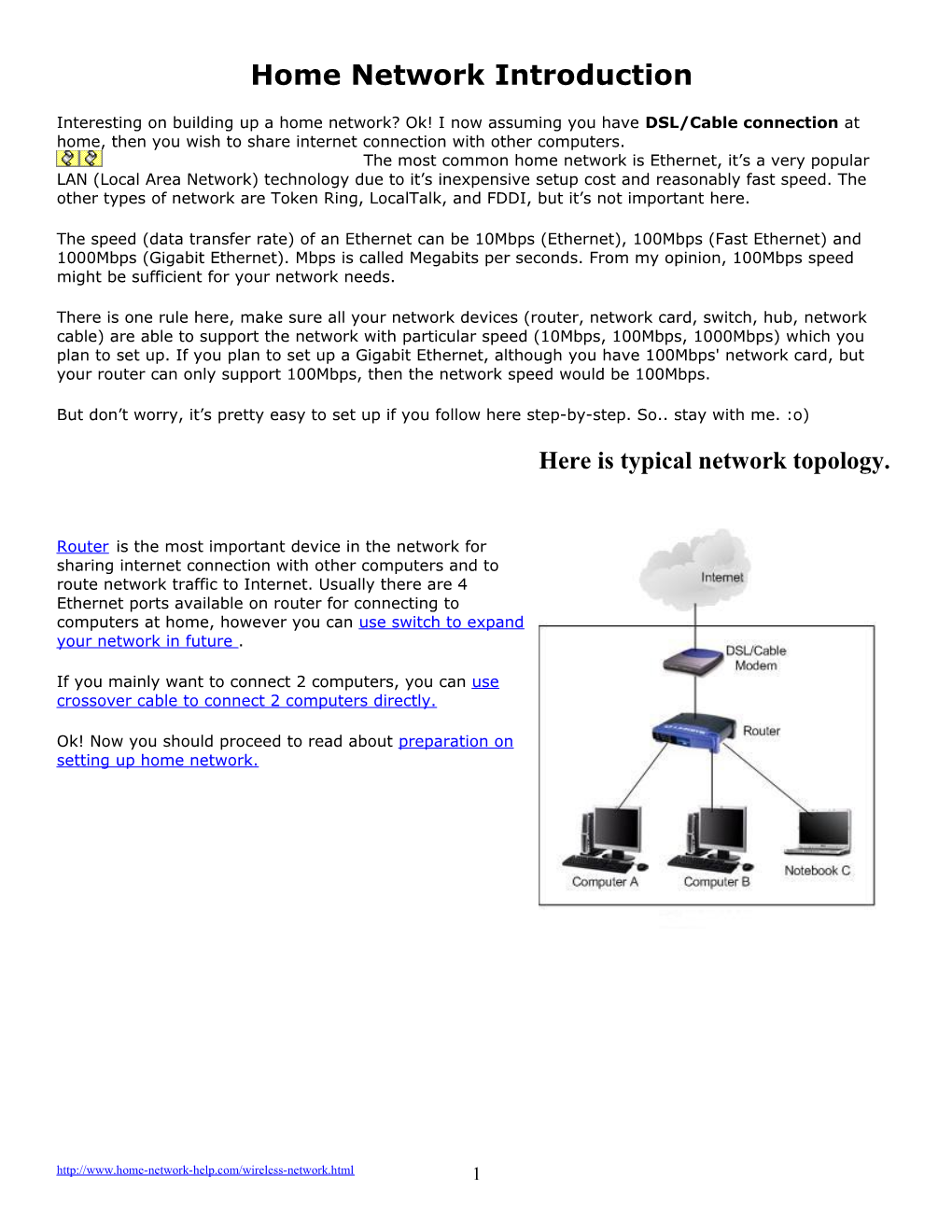Home Network Introduction
Interesting on building up a home network? Ok! I now assuming you have DSL/Cable connection at home, then you wish to share internet connection with other computers.
The most common home network is Ethernet, it’s a very popular LAN (Local Area Network) technology due to it’s inexpensive setup cost and reasonably fast speed. The other types of network are Token Ring, LocalTalk, and FDDI, but it’s not important here.
The speed (data transfer rate) of an Ethernet can be 10Mbps (Ethernet), 100Mbps (Fast Ethernet) and 1000Mbps (Gigabit Ethernet). Mbps is called Megabits per seconds. From my opinion, 100Mbps speed might be sufficient for your network needs.
There is one rule here, make sure all your network devices (router, network card, switch, hub, network cable) are able to support the network with particular speed (10Mbps, 100Mbps, 1000Mbps) which you plan to set up. If you plan to set up a Gigabit Ethernet, although you have 100Mbps' network card, but your router can only support 100Mbps, then the network speed would be 100Mbps.
But don’t worry, it’s pretty easy to set up if you follow here step-by-step. So.. stay with me. :o)
Here is typical network topology.
Router is the most important device in the network for sharing internet connection with other computers and to route network traffic to Internet. Usually there are 4 Ethernet ports available on router for connecting to computers at home, however you can use switch to expand your network in future .
If you mainly want to connect 2 computers, you can use crossover cable to connect 2 computers directly.
Ok! Now you should proceed to read about preparation on setting up home network.
Physical Network Setup
Ok, for your home network, it’s time to do some exercises, here is how I do physical network setup. I will use D-Link's DI-604 broadband router as an example. You can use other type of router according to your needs. Please prepare some straight network cable as well.
Connect the WAN port on router to your cable/DSL modem using straight cable, then connect computers’ network card to router’s LAN ports using straight cable also. You can connect up to 4 computers to this router. Power on the router after finish connecting, you should be able to see the WAN and LAN lights on the router.
Also you need to ensure that your DSL/Cable modem is configured in bridge mode, so that it can work well after connecting to router. If you need more idea, here is an example of configuring DSL modem in bridge mode, you can have a look if you like.
After setting up the network, we need to decide what IP addresses need to be used for router and computers. Click here for more explanation to do IP logical network setup and design.
For the setup that I’m using, I will use IP addresses 192.168.1.1-254, netmask 255.255.255.0.
Next: Network Router Configuration
Content: Home Network Introduction
Back: Preparation on Setting Up Home Network
Return to top!!
What is Wireless Network
Wireless network is a network set up by using radio signal frequency to communicate among computers and other network devices. Sometimes it’s also referred to as WiFi network or WLAN. This
network is getting popular nowadays due to easy to setup feature and no cabling involved. You can connect computers anywhere in your home without the need for wires.
Here is simple explanation of how it works, let say you have 2 computers each equipped with wireless adapter and you have set up wireless router. When the computer send out the data, the binary data will be encoded to radio frequency and transmitted via wireless router. The receiving computer will then decode the signal back to binary data.
It doesn’t matter you are using broadband cable/DSL modem to access internet, both ways will work with wireless network. If you heard about wireless hotspot, that means that location is equipped with wireless devices for you and others to join the network. You can check out the nearest hotspots from your home here.
The two main components are wireless router or access point and wireless clients.
If you have not set up any wired network, then just get a wireless router and attach it to cable or DSL modem. You then set up wireless client by adding wireless card to each computer and form a simple wireless network. You can also cable connect computer directly to router if there are switch ports available.
If you already have wired Ethernet network at home, you can attach a wireless access point to existing network router and have wireless access at home.
Wireless router or access points should be installed in a way that maximizes coverage as well as throughput. The coverage provided is generally referred to as the coverage cell. Large areas usually require more than one access point in order to have adequate coverage. You can also add access point to your existing wireless router to improve coverage.
Wireless Operating Mode
The IEEE 802.11 standards specify two operating modes: infrastructure mode and ad hoc mode.
Infrastructure mode is used to connect computers with wireless network adapters, also known as wireless clients, to an existing wired network with the help from wireless router or access point. The 2 examples which I specified above operate in this mode.
Ad hoc mode is used to connect wireless clients directly together, without the need for a wireless router or access point. An ad hoc network consists of up to 9 wireless clients, which send their data directly to each other. Click here to learn more on this ad hoc mode.
Kindly proceed to read related contents:
802.11 Wireless Standards Used for Wireless Network
Preparation for Wireless Network Setup
Wireless Setup - Connecting Wireless Router
Wireless Router Configuration
Windows 7 Wireless Adapter Configuration
Wireless Adapter Configuration in Vista
Wireless Adapter Configuration in XP
Wireless (Wifi) Network Security
1
